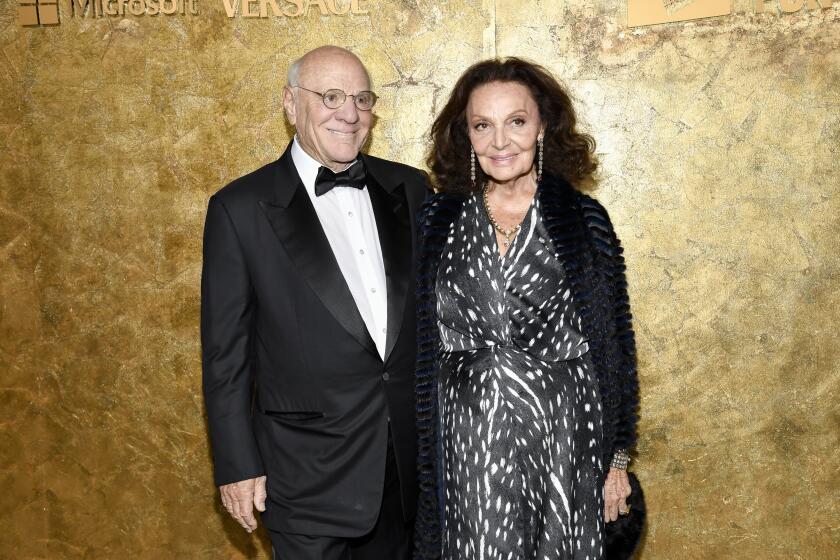KURT MASUR CONDUCTS : LEIPZIG ORCHESTRA IN DISAPPOINTING DEBUT
- Share via
The Gewandhaus Orchestra of Leipzig, which made its preposterously belated Los Angeles debut Tuesday night at Ambassador Auditorium, isn’t just another old-school band.
Its roots go back to 1704. Its roster of conductors has included such names as Telemann, Bach, Mendelssohn, Brahms and Mahler.
There was a time when Leipzig was a major international capital, and the orchestra one of its undoubted glories. That, of course, was before World War II, before the days of painful East/West divisions, Cold Wars, Iron Curtains and Berlin walls.
Culturally, Leipzig has become something of an isolated city. Call it self-sufficient, if you will. Or provincial.
The isolation has not been without artistic consequences. A historical note in the Ambassador program points out, apparently with pride, that 85% of the orchestra players are products of the Leipzig Hoschschule fuer Musik.
The closed artistic society that has resulted might pose no problem if the conservatory in question were producing world-class musicians. That, unfortunately, does not seem to be the case. It would seem, instead, to be producing dutiful civil servants.
The finest instrumental ensembles these days are melting pots, organizations that bring together the strongest talents from vastly disparate sources. The finest ensembles are active internationally, fiercely competitive, responsive to the latest artistic developments, constantly pursuing new heights of virtuoso force as well as technical refinement.
Such certainly would seem to be the case in Chicago and Amsterdam, in London and Vienna, in Philadelphia and West Berlin. . . .
If one may judge by a single tour performance--admittedly a dangerous judgment--Leipzig has a different perspective and a different set of values.
Separated from all the conventional traffic arteries, the city does not--cannot--compete in the big symphonic leagues anymore. It concentrates instead on being gemuetlich .
Gemuetlich is a nice, multi-purpose German word. It can connote warmth, congeniality, good-natured coziness. Indeed, the playing of the Gewandhaus Orchestra often reflects those qualities.
The word also can suggest a certain casualness, a penchant for the untidy, a disregard for precision. Indeed, the playing of the Gewandhaus Orchestra reflected those qualities Tuesday night in Pasadena.
The untidiness actually was alarming. If the American Youth Symphony or the YMF Orchestra allowed the technical lapses that marred the first Leipzig performance here, we would have serious second thoughts about the quality of our musical training.
But here was the venerable, potentially glamorous foreign orchestra which, according to the program blurb, is celebrated for its “balance and unanimity of ensemble.”
And here was a jumble of scrawny strings, strident brass, excruciatingly pinched oboe tones, scrappy winds, ragged entrances, laissez-faire cutoffs, flubbed cues, mushy textures, chronic pitch problems and only approximate dynamics.
Kurt Masur, who has been music director of the Gewandhaus since 1970, is a hearty, no-nonsense Old-World maestro. He favored appealing lyrical simplicity and poise in the Schubert “Unfinished” Symphony. He enforced constant forward momentum, even in the potentially numbing longueurs of the Bruckner Fourth (performed here in the Haas edition).
He kept the textures light, even when bathos lurked on the expressive horizon. He certainly did arouse his prosaic band to some affecting raw-power climaxes.
He obviously has interesting interpretive ideas, and one admires his restraint. One would like to hear him again, with a first-rate orchestra.
Still, he must bear at least some of the responsibility for the current Leipzig standard. The Gewandhaus Orchestra is, for better or worse, his orchestra. While most music directors in the western world function essentially as guest conductors and absentee landlords, he spends up to seven months a year at home.
That gives one pause.
More to Read
The biggest entertainment stories
Get our big stories about Hollywood, film, television, music, arts, culture and more right in your inbox as soon as they publish.
You may occasionally receive promotional content from the Los Angeles Times.










